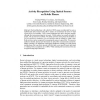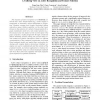281 search results - page 13 / 57 » Peer-to-Peer Application Recognition Based on Signaling Acti... |
GI
2009
Springer
13 years 12 months ago
2009
Springer
: Each mobile phone with a built-in CMOS sensor can inherently be seen as sophisticated optical sensor being able to analyze its environment in terms of visual events and its own m...
CVPR
2011
IEEE
12 years 11 months ago
2011
IEEE
Cameras are ubiquitous everywhere and hold the promise of significantly changing the way we live and interact with our environment. Human activity recognition is central to under...
SIGKDD
2010
13 years 2 months ago
2010
Mobile devices are becoming increasingly sophisticated and the latest generation of smart cell phones now incorporates many diverse and powerful sensors. These sensors include GPS...
ICCV
2003
IEEE
14 years 9 months ago
2003
IEEE
The objective of active recognition is to iteratively collect the next "best" measurements (e.g., camera angles or viewpoints), to maximally reduce ambiguities in recogn...
CSCW
2004
ACM
14 years 24 days ago
2004
ACM
A number of studies have explored issues of interruption and availability in workplace environments, but few have examined how attitudes toward availability play out in home life....


